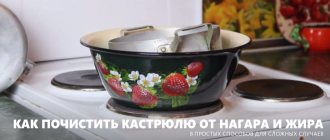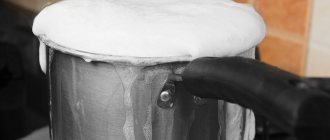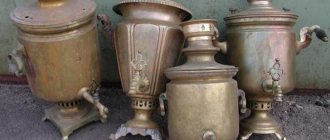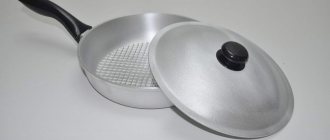It is impossible to be a perfect cook and never make mistakes while preparing food. Every woman has encountered an unpleasant situation when, due to inattention, incorrect proportions of ingredients, or too long cooking, food managed to burn to the bottom of the pan. The situation is not fatal, but the aesthetic appeal of the dishes is reduced. If carbon deposits settle on the outside of the pan, it creates an impression of sloppiness in terms of cleaning dishes and cleaning the house.
Light stains on the pan can be removed with detergents.
Pros of a stainless pan
The demand for stainless steel cookware is due to a number of advantages that the alloy has. Steel pans benefit from aesthetics. The use of the latest technologies in production allows the manufacturer to implement the most daring design solutions. Stainless steel household items are easy to clean.
There is no fear that the protective coating will be damaged or scratches will remain on the surface. Due to the resistance of the alloy to the formation of microcracks, bacteria do not linger in the dishes. This fact indicates the hygiene of the pans.
An undeniable advantage is the long service life of stainless steel cookware. It can be used for decades without loss of quality. The alloy is not subject to oxidation, which eliminates the formation of rust. The secret of high corrosion resistance lies in the chromium content. It forms a thin film on the metal surface that performs protective functions.
With proper care, appearance does not indicate how long ago the cookware was purchased. It always looks like new.
One of the most important advantages of stainless steel pans is the fact that the alloy does not react with food. This eliminates the influence of metal on the taste of dishes prepared in steel cookware.
Strong arguments in favor of stainless steel are overshadowed by one nuance - the high thermal conductivity of the alloy. Because of this property, the pan is prone to burning. In order to eliminate such a nuisance, manufacturers make the bottom of 2-3 layers. The interlayers are made of metal with a lower thermal conductivity (copper, aluminum, etc.).
Types of pollution
No one is immune from annoying mistakes that cause food to burn on a stainless steel pan. Both an inexperienced housewife and a top-class cook had to face this situation.
Your own carelessness leads to the formation of a layer of burnt food. If you can deal with soot on the outside using regular washing using special products, then removing the burnt on the inside is not easy. A stainless steel pan not only loses its aesthetics, but also becomes unsuitable for further use.
The contaminants that form inside the dishes are of the following types:
- from porridge (especially after cooking rice, wheat and millet);
- from milk;
- from jam (most often happens when cooking low-juiciness fruits);
- from sugar (preparing syrups, caramel, etc.);
- fat;
- carbon deposits on the walls;
- rainbow stains and spots.
To get your stainless steel pan back looking beautiful, you need to choose an effective cleaning method.
Recommendations
Expert advice will help you clean your dishes as efficiently as possible:
- If the cause of food burning is damage to the non-stick layer, then it is better to throw away such dishes, since using such a pan is not only unpleasant, but also harmful to health due to carcinogenic substances getting into the food.
- The use of the cleaning composition must be carried out according to the instructions, in compliance with safety precautions.
- When choosing the consistency of the cleaning product, it is necessary to take into account that powders can scratch the surface of the material, and sprays are used only if there is good ventilation.
Folk remedies for cleaning
Available methods that involve the use of improvised means will help you get rid of the burnt layer on the inner surface of stainless steel cookware.
Activated carbon
The worst thing to clean is the remains of burnt cereals. You can get rid of them by treating the surface with activated carbon. To do this, you first need to grind the tablets into powder and sprinkle it on the dirt. A few drops of water are added to form a paste. It takes 30 minutes to soften the burn. If fragments of dirt remain after cleaning, repeat the procedure.
Soda and vinegar
The reaction of alkali and acid gives the effect of gas formation. This can be used in the fight against burntness. In addition, each of the components has a softening effect, which makes the cleaning product more effective.
Algorithm for removing carbon deposits:
- The bottom and side surfaces of the pan are rubbed with a paste of soda and water (the composition is generously distributed over the dirt).
- Pour vinegar into the soda layer.
- Let the mixture sit for 1 hour.
- Clean the container.
Lemon acid
The cleaning process includes the following steps:
- Fill a stainless steel pan with water (to cover the burnt parts) and let it boil.
- Add citric acid to the boiling liquid and boil for another 20 minutes.
- After draining the solution from the container, perform the usual cleaning and rinsing.
Milk serum
Positive reviews can be found on forums regarding cleaning stainless steel with whey. According to users, you can get rid of soot, scale, burnt food and rainbow spots. The pan is filled with the dairy product to a level that covers the contamination by 1 cm. After a day, the settled liquid is drained. Next, a normal wash is performed.
Coca Cola
The popular drink is poured into a stainless steel container and placed on fire. Let the liquid boil for a couple of minutes and remove the pan from the stove. After draining the cola, wash the surface with soapy water until the particles of burnt food disappear.
Coffee grounds
There is no need to rush to throw coffee grounds in the trash. It can be used as a safe abrasive that helps remove burnt marks on the surface of stainless steel. In this case, the pan will remain intact and unharmed.
- The grounds are distributed over the contaminated surface of the dish.
- Using a sponge, rub the coffee mixture into the soot until the burnt food particles dissolve.
- Rinse thoroughly under running water.
If after 3 treatments the burnt part does not peel off, you need to try another cleaning method.
The nuances of removing various food burnt inside from the bottom
Depending on what product is burnt in the pan, you can choose the most suitable processing option.
Sugar containing products
When sweet desserts (baked goods, jam, syrup) burn, it is advisable to use acidic cleaning compounds . If caramel or jam is burnt, you should not leave cleaning the pan for later. First you need to pour high-temperature water into it and let it stand for at least 3-5 hours.
If soaking does not help resolve the issue, the pan should be boiled with a cleaning agent, which is selected based on the material of the dishes.
If the burn from sweet food has hardened and the treatment has not been carried out in time, it will be difficult to clean the pan. You will have to act in several stages, combining soaking, boiling and scrubbing.
Milk
Burnt milk not only spoils the inside of pans, but also has an unpleasant odor. For cleaning, both acids (for example, lemon) and activated carbon or soda can be used.
If boiling milk is carried out frequently, it is recommended to purchase a special pan - a milk boiler . It has a special structure with two layers of walls.
This video will show you how to clean a pan from burnt milk:
Meat, potatoes
If a potato or meat dish is burnt, fill the pan with water as quickly as possible and let it sit. As a result, the deposits will begin to lag behind and can be removed. In order not to damage the surface, cleaning must be carried out in stages, in several passes.
Porridge
Cereals contain a large amount of fiber . This makes it easier to scrape burnt porridge from the bottom of the pan. You should start by soaking the affected bottom and walls. To do this, pour hot water into the container and leave the pan for at least half an hour. In advanced cases, you can try boiling.
Fat
It is not easy to remove burnt fat from a pan. Soaking in this case will not give a clear result. Mustard powder and soda will help deal with fresh soot. To quickly clean a long-burnt pan, it is more convenient to use special household chemicals.
How to clean the outside of a pan
You can get rid of contaminants located at the bottom of the pan from the outside using one of the convenient methods.
Soda
The safest option for cleaning dishes from carbon deposits is boiling. Soda liquid is used as a solvent. To do this, dilute baking soda in a large container with water (1 glass per 3-4 liters of water). Afterwards, a dirty stainless steel object is immersed in it and allowed to boil for 30-50 minutes.
The procedure time depends on the thickness of the soot and deposits. If the layer is dense, you can add finely ground laundry soap (1/3 of a bar) to the working solution. Next, the dirt is removed with a sponge with a hard surface.
Old stains may not come off the first time, so the procedure is repeated 2-3 times.
A small deposit is removed under warm running water after rubbing the bottom of the pan from the outside with soda. A metal sponge will help remove any remaining dirt. Another cleaning option involves using a paste of baking soda and hydrogen peroxide as a cleaning agent. After mixing the components, the mixture is distributed along the bottom. After 15 minutes, remove any remaining burnt food with a sponge.
Stationery glue with laundry soap
The essence of the method is to boil a dirty stainless steel pan in a solution of the following ingredients:
- water – 4 l;
- stationery glue – 100 ml (can be replaced with PVA glue);
- laundry soap - 1/3 bar.
After the soap has dissolved, the product is poured into a large container and placed on fire. As soon as the liquid boils, lower the contaminated container and leave it in it for half an hour. The fire is reduced to a minimum. If the deposit is old, then the procedure is carried out for 1-2 hours. As the solution boils, add water. The cleaning process is completed by rinsing the pan using a hard sponge.
Glass cleaner
Stains and stains of unknown origin that often appear on the outside of stainless steel cookware can be removed with a glass cleaner. First, wash the pan with soapy water.
After rinsing and drying, spray a little spray and rub the surface with a microfiber cloth. Shine after this treatment is guaranteed.
It is prohibited to use sponges with abrasive surfaces or metal brushes to remove carbon deposits from stainless steel. The exception is the outer side of the bottom.
Using apple peel
Sour green apples, namely their peel, will help quickly restore the shine to stainless steel. It is necessary to peel several apples and boil them in plain water in a burnt pan for half an hour.
But if the soot is very old, you will have to boil the peel several times. For greater efficiency, it is recommended to add a little table vinegar to the broth when boiling.
Household cleaning products
In case of severe or old contamination, it is advisable to use special formulations developed on the basis of chemical compounds.
Sano Forte grease and carbon remover 0.5 l
The Israeli-made product is available in the form of a spray. Purpose – cleaning the surfaces of kitchen appliances, glass-ceramic and stainless steel dishes, tiles. Suitable for removing long-standing stains of various origins: grease, soot, soot, etc.
- moisten the surface with warm water;
- apply the product, forming a thin layer;
- let stand for 10-15 minutes to soften scale or dirt deposits;
- Wipe with a damp sponge until completely clean.
If necessary, the procedure is repeated 2-3 times until the desired result is obtained. Cost: 332 rubles.
Cleaning and degreasing agent for dishes with non-stick coating Organics 500 ml
An environmentally friendly product designed for washing dishes made from different materials:
- with Teflon coating;
- stainless steel;
- ceramics;
- aluminum
The presence of any non-stick layer is cleaned efficiently using the Organics composition.
The product is available in the form of a spray. To remove soot, just spray it on the surface and let it sit for 15 minutes. The process is completed by rinsing the dishes using a sponge.
The degreasing effect is ensured by the inclusion of active substances in the composition: nonionic and cationic surfactants obtained from plant materials, as well as an organic solvent. Manufacturer: Ukraine. Cost: 250 rubles.
Stainless steel cleaner HG 341030161
The powerful product is a professional product. Easily copes with lime deposits, grease deposits, fingerprints and other types of dirt. Recommended for use for cleaning kitchen utensils made of aluminum and stainless steel. The product is also active against carbon deposits and grease deposits accumulated on chrome.
The product is suitable for washing sinks, taps, furniture fittings, pots, pans and other household items.
Production: Netherlands. Cost: 475 rub. per bottle of 300 ml.
What is not recommended for washing and cleaning the pan?
You should not use products containing abrasive particles to remove carbon deposits on stainless steel. They can leave scratches and other damage on the surface. This limitation applies to metal jaws and those equipped with a hard layer. The only place where they can be used is the bottom from the outside.
Some housewives choose the easiest way to wash pots - using a dishwasher. A good result will not work if you do not first soak the container in warm water. The purpose of the procedure is to soften the burnt layer of food and dried particles. Before loading into the washing unit, it is necessary to remove as much contamination as possible.
Experts do not recommend cleaning stainless steel dishes in automatic washing machines.
To clean stainless steel pans, you cannot use aggressive chemical compounds whose active substances react with metals. This applies to concentrated products based on acids, chlorine and alkalis, intended for stoves, tiles, and plumbing fixtures.
Useful tips for care and use
- To clean stainless steel products, use mild detergents. Manufacturers recommend avoiding temperature changes for such cookware, so wash the pan immediately after it has cooled down, but food particles have not had time to dry.
- Do not use hard scourers or abrasives.
- It is not recommended to use a dishwasher to avoid chips and scratches. But, if the steel is strong enough and the manufacturer allows this method, pre-soak the pan in soapy water.
- To avoid water stains, wipe the dishes dry after each wash.
- Ammonia and toothpaste will help get rid of rainbow stains on stainless steel. Mix these two ingredients to make a solution. The paste should be the most common one, without whitening particles. Soak a napkin in the mixture and wipe problem areas. Rinse with cold water.
- To add shine, rub the pan with half a raw potato.
- You can also use glass cleaner for a sparkling shine. Spray a small amount onto the surface and rub with a soft cloth.
Pollution prevention
After a long period of use of stainless steel pans, the surfaces begin to deteriorate. To maintain aesthetics, you need to regularly carry out preventive measures:
- Wash the inside and outside of cookware after each cooking.
- When using degreasers, it is important to rinse thoroughly.
- After washing, wipe the pots dry using a soft, dry, lint-free towel; this will prevent the appearance of streaks, stains, and cloudiness.
- Do not expose stainless steel to sudden temperature changes, as this will shorten the life of the product.
- If the beautiful shine is lost, it is recommended to rub the surfaces with peeled potatoes.
- You can make cleaning easier by detaching the removable parts.
- Plastic parts should be removed before boiling or soaking in boiling water.
- It is easier to clean stains on stainless steel if you wipe them on a pan that has not yet cooled; they are more difficult to remove from a cold surface.
Only regular maintenance ensures the preservation of the aesthetic appearance and integrity of stainless steel. It’s nice to cook delicious dishes for loved ones in such dishes.











